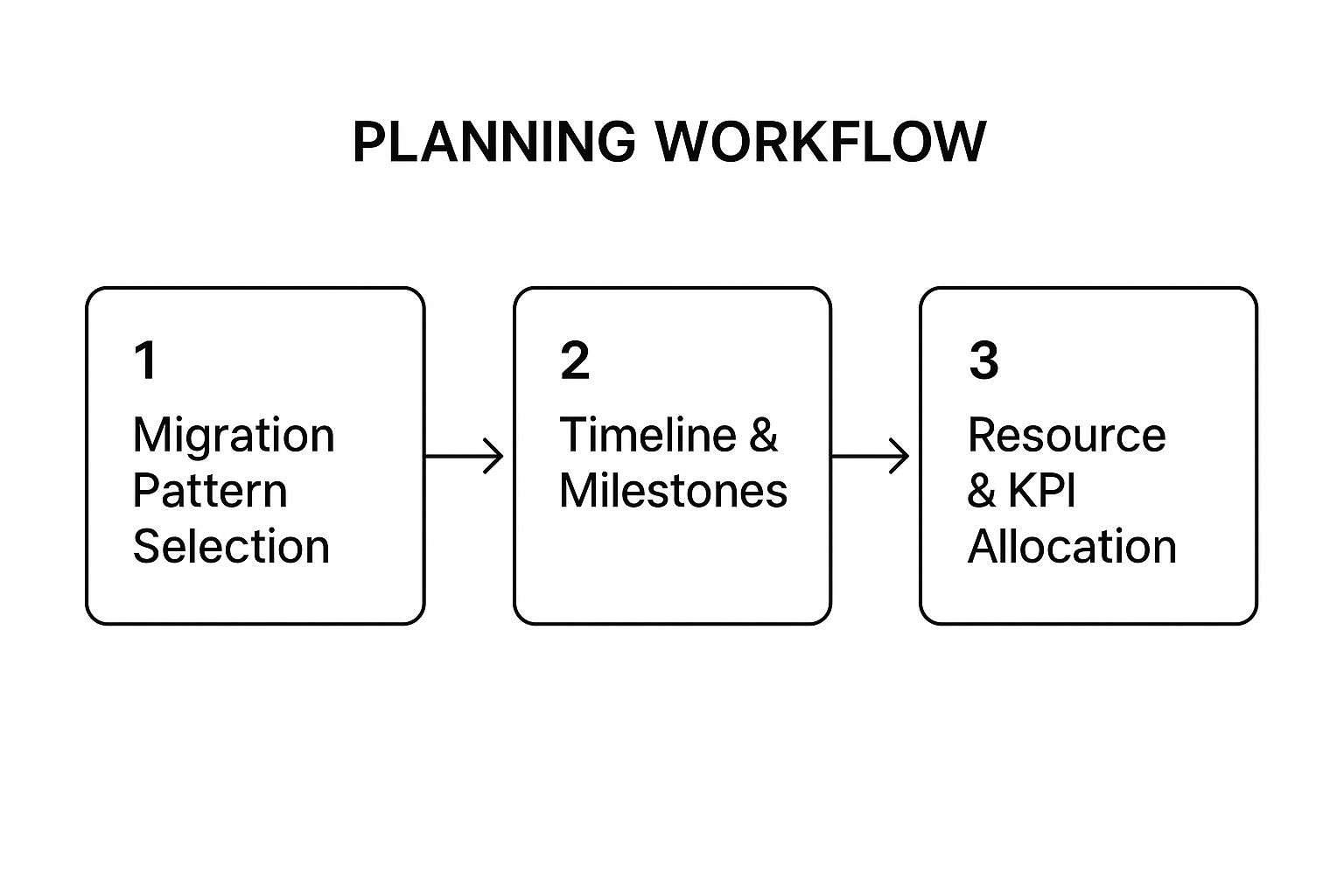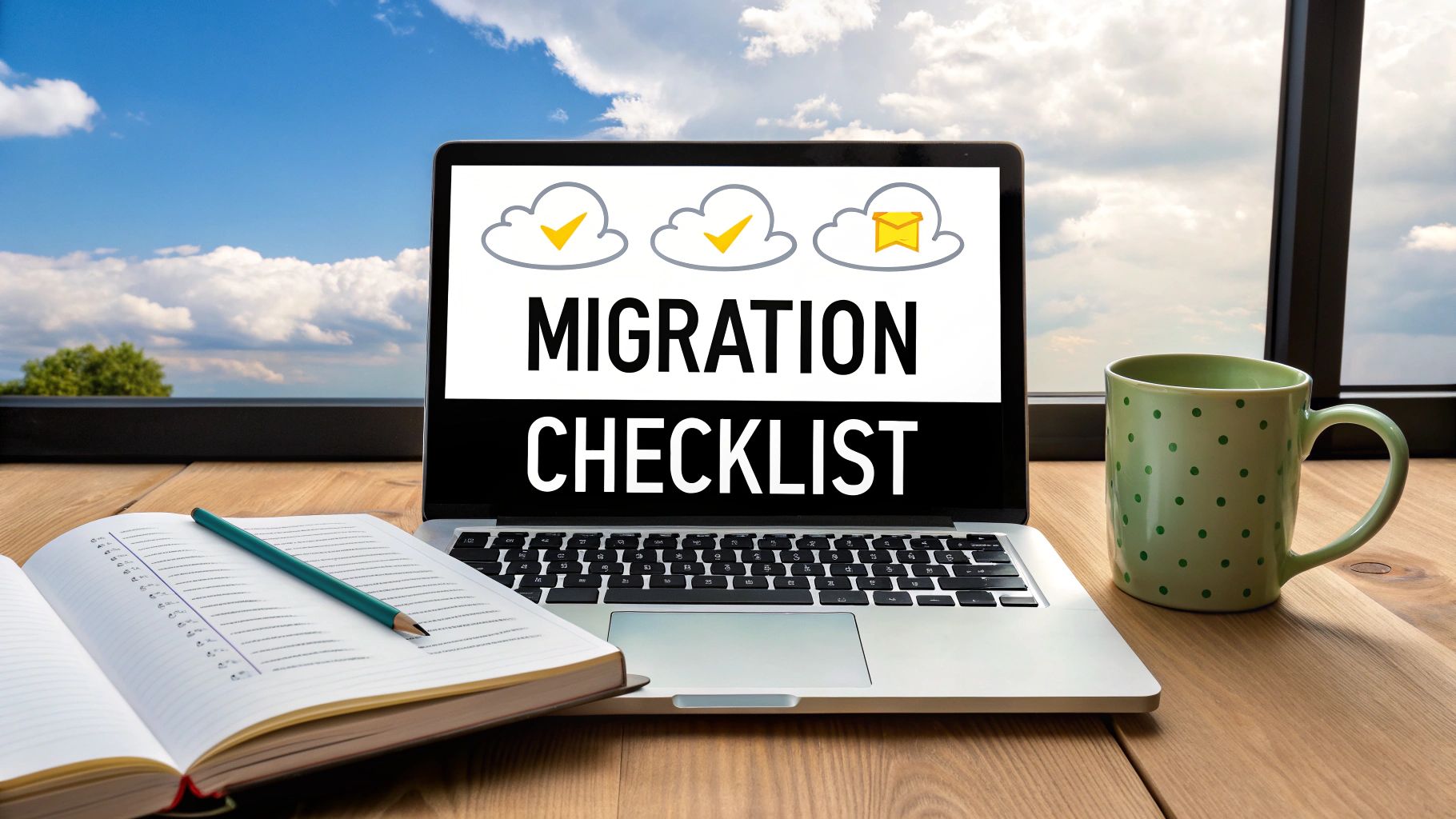Embarking on Your Cloud Journey: Why a Detailed Plan is Non-Negotiable
Migrating to the cloud is more than a technical shift; it’s a strategic business transformation that promises enhanced agility, scalability, and innovation. A successful journey from on-premises infrastructure to a dynamic cloud environment, however, does not happen by chance. It demands meticulous planning, a deep understanding of your existing systems, and a clear vision for your future state. Without a comprehensive roadmap, organizations risk significant budget overruns, critical security vulnerabilities, and disruptive operational downtime that can impact everything from guest services in a hotel to resident access in a multi-family property.
This definitive cloud migration checklist provides an 8-step framework designed to navigate you through every critical phase of the process. We will move beyond high-level theory to provide actionable steps and practical insights, ensuring your transition is both smooth and strategic. By following this structured guide, you can de-risk your migration, ensure tight alignment with your core business objectives, and unlock the full potential of your new cloud environment.
This article will break down the entire process into manageable, sequential stages, covering:
- Assessment and Discovery: Understanding what you currently have.
- Strategy and Planning: Defining your goals and how you’ll get there.
- Security and Compliance: Building a secure foundation from day one.
- Architecture and Design: Creating your future-state cloud environment.
- Data Migration: Planning the secure and efficient move of your data.
- Testing and Validation: Ensuring everything works before you go live.
- Execution and Cutover: The final switch to the cloud.
- Post-Migration Optimization: Continuously improving performance and cost.
Let’s begin building the detailed plan that will transform this complex undertaking into a manageable and highly rewarding initiative for your organization.
1. Assessment and Discovery
Every successful journey begins with a map, and in a cloud migration, that map is created during the Assessment and Discovery phase. This foundational step is the first and arguably most critical item on any comprehensive cloud migration checklist. It involves a deep, thorough evaluation of your existing IT environment, including all servers, applications, data, and network configurations. The goal is to build a complete inventory of what you have, understand how it all connects, and establish performance baselines to measure success later.

Without this initial groundwork, you are essentially migrating blind. You risk overlooking critical system dependencies, under-provisioning resources, or facing unexpected compatibility issues that can derail the entire project. This phase isn’t just a technical exercise; it also involves a business impact assessment to align the migration with strategic goals and ensure key stakeholders are involved from the very beginning.
How to Conduct a Thorough Assessment
A proper assessment moves beyond a simple server count. It requires a multi-faceted approach to gather the right data for informed decision-making.
- Automated Discovery: Manually cataloging hundreds or thousands of assets is impractical and prone to error. Use automated discovery tools to scan your environment. Leading cloud providers offer robust solutions like AWS Application Discovery Service, Azure Migrate, or Google Cloud’s StratoZone. These tools can map server specifications, running processes, network connections, and application dependencies automatically.
- Dependency Mapping: One of the biggest migration risks is a hidden dependency. For instance, a front-facing customer application might rely on a little-known legacy database. Dependency mapping tools visualize these connections, ensuring you migrate interconnected components together to avoid breaking applications. Capital One famously conducted extensive dependency mapping, which was crucial for their successful, large-scale migration to AWS.
- Performance Baselining: You cannot improve what you do not measure. Before migrating, collect performance data on your current infrastructure. Key metrics include CPU and memory utilization, disk I/O, and network throughput for your key applications. This baseline will be invaluable for validating performance and right-sizing your cloud instances post-migration, preventing overspending.
- Business and Stakeholder Interviews: Technology does not operate in a vacuum. Interview application owners and business unit leaders to understand usage patterns, seasonality, compliance requirements (like HIPAA or PCI DSS), and future growth expectations. This qualitative data is just as important as the technical metrics.
2. Strategy and Planning
With a complete inventory from the discovery phase, the next critical item on your cloud migration checklist is to formulate a robust Strategy and Planning framework. This is where you transform raw data into an actionable blueprint. It involves defining your migration approach, establishing a realistic timeline, allocating resources effectively, and setting clear success criteria. This strategic plan acts as your project’s north star, guiding every decision from technical execution to financial management.

This strategic workflow ensures that you move from high-level goals to granular execution in a structured manner. Properly sequencing these planning stages prevents a disjointed migration where technical choices are misaligned with business timelines and objectives. A well-defined strategy is the difference between a chaotic, over-budget project and a smooth, value-driven transition to the cloud.
How to Build a Comprehensive Migration Strategy
An effective strategy moves beyond just picking a cloud provider. It requires a detailed, methodical approach to ensure alignment across technology and business units.
- Select Migration Patterns: Not all applications are migrated the same way. Use the “6 R’s” framework (Rehost, Replatform, Refactor, Repurchase, Retire, Retain) to assign a specific migration path for each application based on its complexity, business value, and technical dependencies. For example, a simple, non-critical internal app might be a good candidate for a “Rehost” (lift-and-shift), while a core customer-facing application might benefit from a “Refactor” to leverage cloud-native services, similar to how Spotify’s strategy focused on containerization.
- Develop a Phased Timeline: A “big bang” migration is incredibly risky. Instead, group applications into logical migration waves, starting with low-risk, high-impact workloads. This allows your team to learn and refine the process. Plan for a 20-30% buffer in your timeline to account for unforeseen challenges. Each phase should have clear start dates, end dates, and defined milestones.
- Define Success Criteria: How will you know if the migration was successful? Establish clear, measurable Key Performance Indicators (KPIs) before you start. These could include improved application response time, a specific percentage reduction in operational costs, or achieving a target uptime of 99.99%. These criteria are essential for validating the project’s return on investment.
- Align with Business Objectives: Ensure your migration strategy directly supports larger business goals. If the company’s objective is to expand into a new geographic region, your strategy should prioritize migrating the applications necessary to support that expansion and leverage the cloud provider’s global footprint. This alignment secures executive buy-in and ensures the project delivers tangible business value.
3. Security and Compliance Planning
Security isn’t an afterthought in a cloud migration; it’s a fundamental design principle that must be woven into every stage of the process. This critical phase of your cloud migration checklist involves building a robust security and governance framework from the ground up. It means proactively addressing how you will protect data, manage user access, and meet strict regulatory standards in your new cloud environment, rather than trying to bolt on security controls after the fact.

Neglecting this step exposes your organization to significant risks, including data breaches, non-compliance penalties, and reputational damage. A “lift and shift” of on-premises security policies is rarely effective, as the cloud operates on a shared responsibility model. You must understand which security tasks the cloud provider handles (like physical security of data centers) and which remain your responsibility (like data encryption and access controls).
How to Implement a Robust Security Plan
A successful security and compliance strategy requires a deliberate and multi-layered approach that aligns with both business and regulatory requirements.
- Adopt a “Security by Design” Mindset: Integrate security into the earliest planning stages. Engage your security and compliance teams from day one. This involves mapping your existing security controls to cloud-native services and adopting frameworks like the AWS Well-Architected Security Pillar or Microsoft’s Zero Trust security model. For instance, a financial institution like JPMorgan Chase builds its cloud strategy around a comprehensive, custom security framework that addresses regulatory oversight from the outset.
- Define Identity and Access Management (IAM): Control who can access what. Implement the principle of least privilege, granting users only the permissions they absolutely need to perform their jobs. Utilize strong authentication methods, such as multi-factor authentication (MFA), and leverage cloud provider IAM services like AWS IAM or Azure Active Directory to create granular roles and policies.
- Leverage Cloud Provider Compliance: Cloud providers invest heavily in achieving certifications for various regulations and standards. Before migrating, review your provider’s compliance reports for standards relevant to your business, such as GDPR, HIPAA, or PCI DSS. Philips Healthcare successfully navigated its cloud migration by building its architecture on top of AWS’s HIPAA-eligible services, drastically simplifying their own compliance efforts.
- Automate Security with Infrastructure as Code (IaC): Use tools like Terraform or AWS CloudFormation to define and deploy your security configurations as code. This ensures that security policies, firewall rules, and access controls are applied consistently across all environments, reducing the risk of human error and configuration drift. For organizations seeking specialized expertise, exploring managed security solutions on clouddle.com can provide a significant advantage in maintaining this consistency.
4. Architecture Design and Optimization
Once you know what you have, the next step in the cloud migration checklist is to design where you are going. This is the Architecture Design and Optimization phase, a crucial stage where you blueprint your future state in the cloud. It involves moving beyond a simple “lift-and-shift” mindset to create a target architecture that is performant, scalable, cost-effective, and resilient by design. The goal is to leverage cloud-native capabilities to build an environment that not only supports your current applications but also enables future innovation.

Failing to properly design your cloud architecture is like building a house without a blueprint. You risk creating a system that is insecure, expensive to run, and prone to failure. This phase translates your business requirements and technical findings from the assessment stage into a concrete technical plan. For example, Netflix’s legendary migration to AWS involved a complete re-architecture to a highly available, globally distributed microservices model, enabling the resilience and scale they are known for today.
How to Design an Optimized Cloud Architecture
A well-designed architecture is built on established principles and tailored to your specific needs. It requires a strategic approach that balances performance, cost, and reliability.
- Follow the Well-Architected Framework: Do not reinvent the wheel. Major cloud providers offer blueprints for success through their respective frameworks: the AWS Well-Architected Framework, Microsoft Azure Architecture Center, and Google Cloud Architecture Framework. These frameworks provide a set of best practices across key pillars like operational excellence, security, reliability, performance efficiency, and cost optimization. Adhering to these principles is a proven path to building a robust and efficient cloud environment.
- Design for Failure: In the cloud, you must assume components will fail. Instead of preventing all failures, design systems that can gracefully handle them. This involves using multiple Availability Zones (AZs) for high availability, implementing automated failover, and using patterns like circuit breakers to prevent a localized issue from cascading across your entire application. This proactive approach ensures your services remain available even when underlying infrastructure experiences problems.
- Use Managed Services: Reduce your operational burden by leveraging managed services wherever possible. Instead of managing your own database server on a virtual machine, use a managed database service like Amazon RDS or Azure SQL Database. These services handle patching, backups, and failover automatically, freeing up your team to focus on application development rather than infrastructure management.
- Prioritize Network Design: Your network is the backbone of your cloud environment. A well-planned network topology is essential for security, performance, and scalability. This includes correctly configuring Virtual Private Clouds (VPCs), subnets, and security groups to isolate workloads and control traffic flow. You can explore how detailed network design and verification with heatmapping can ensure optimal performance and prevent bottlenecks.
5. Data Migration Planning
The heart of any IT system is its data, and moving it securely and efficiently is a monumental task that requires its own dedicated strategy. Data Migration Planning is a critical phase in any cloud migration checklist where you design the roadmap for transferring data from legacy on-premises systems to new cloud storage solutions. This process involves classifying data, selecting the right transfer methods, and ensuring data integrity, all while minimizing disruption to business operations.
Failing to plan data migration properly can lead to catastrophic outcomes, including data loss, extended downtime, and compliance breaches. A well-executed plan, on the other hand, ensures that your most valuable asset arrives in the cloud intact, secure, and ready for use. For example, shipping giant Maersk successfully migrated over 600 TB of data to Microsoft Azure by employing a carefully planned hybrid approach that combined online transfers with physical data shipping for massive datasets.
How to Execute a Data Migration Plan
A robust data migration plan addresses the “how,” “when,” and “what” of your data transfer, moving from high-level strategy to granular technical details.
- Classify and Prioritize Your Data: Not all data is created equal. Start by classifying data based on its business criticality, sensitivity, and usage patterns. This will help you decide which datasets to move first and what level of security to apply. You might prioritize migrating active transactional databases before moving cold archival data.
- Select the Right Migration Method: Your choice of method depends on data volume, network bandwidth, and your tolerance for downtime. For smaller datasets, an online transfer over the internet might suffice. For large-scale migrations, a hybrid approach using services like AWS Snowball or Azure Data Box (physical appliances shipped to your data center) can be faster and more reliable. Services like AWS Database Migration Service (DMS) or Azure Data Factory are excellent for live database migrations with minimal downtime.
- Implement and Test Data Integrity Checks: How do you know all your data made it across correctly? Implement verification procedures like checksums or hash comparisons to validate data integrity before and after the transfer. Running pilot migrations with non-critical datasets allows you to test these procedures and your overall process thoroughly.
- Plan for Minimal Downtime: For mission-critical applications, a “big bang” migration with significant downtime is not an option. Use techniques like incremental synchronization, where an initial full backup is followed by continuous updates of any changes. This keeps the on-premises and cloud data in sync, allowing you to cut over with a very short maintenance window.
6. Testing and Validation Strategy
Migrating applications and data to the cloud without rigorous testing is like launching a rocket without a pre-flight check; you are inviting disaster. A comprehensive Testing and Validation Strategy is a non-negotiable item on your cloud migration checklist. This phase ensures that your applications not only function correctly in the new cloud environment but also meet performance, security, and integration standards before they go live and impact your users. It is the final quality gate before the cutover.
Neglecting this step can lead to degraded performance, unexpected downtime, security vulnerabilities, or a poor user experience, undermining the very benefits you sought from the cloud. This strategy is not a single event but a multi-layered process that validates every aspect of the migrated workload, from individual code components to the end-to-end user journey. It’s about building confidence that the new environment is ready for production.
How to Build a Robust Testing Plan
A successful validation strategy involves multiple types of testing, each designed to scrutinize a different aspect of the migrated system.
- Implement a Multi-Layered Testing Approach: Your plan must be comprehensive. Start with unit and integration testing to ensure individual components and interconnected services work as designed. Progress to performance and load testing to validate that the application can handle expected user traffic and stress conditions. For instance, ING Bank conducted rigorous security and performance testing during their cloud transformation to ensure compliance and reliability.
- Automate Wherever Possible: Manual testing is slow, expensive, and inconsistent. Leverage cloud-native and third-party tools to automate your testing pipelines. Frameworks popularized by Microsoft’s DevOps methodologies allow for continuous testing to be integrated directly into your deployment process. This ensures every change is validated automatically, increasing speed and reducing human error.
- Test in a Production-Like Environment: Testing in an environment that doesn’t mirror production is a recipe for failure. Your test environment should use a copy of production data (anonymized for security) and be configured to match the production cloud environment as closely as possible. This is the only way to get accurate performance benchmarks and uncover configuration-specific bugs.
- Include Failure and Recovery Scenarios: The cloud’s resilience is a key benefit, but it needs to be tested. Practices like Netflix’s Chaos Engineering deliberately introduce failures into the system, such as terminating instances or injecting latency, to ensure your application’s fault tolerance and disaster recovery plans work. This proactive approach builds a truly resilient system.
- Conduct User Acceptance Testing (UAT): The final verdict on success comes from your users. Involve a group of end-users to perform real-world tasks in the new environment. Their feedback is invaluable for catching usability issues and confirming that the application meets business requirements from their perspective.
7. Migration Execution and Cutover
This is the pivotal moment in your cloud migration checklist where all the planning, strategizing, and testing culminates in action. Migration Execution is the hands-on process of moving your selected applications, data, and workloads to the new cloud environment. The cutover is the precise point in time when you switch from the old on-premises system to the new cloud-based one, making it the live production environment. This phase requires meticulous coordination, technical precision, and clear communication to minimize downtime and business disruption.
Executing this step flawlessly is what defines a successful migration. A well-managed cutover feels seamless to end-users, while a poorly handled one can lead to extended outages, data loss, and a loss of confidence in the project. Companies like Coca-Cola have demonstrated excellence here, migrating massive SAP workloads to AWS with virtually zero downtime by employing sophisticated replication and synchronization strategies. This phase is the true test of your preparation and the strength of your migration plan.
How to Ensure a Smooth Execution and Cutover
A successful migration doesn’t happen by chance; it is the result of rigorous planning and a disciplined execution strategy. Here are the key elements to focus on.
- Practice and Rehearse the Cutover: Do not let the production migration be your first attempt. Conduct multiple dry runs or mock cutovers in a staging environment that mirrors production. This builds muscle memory for the team, validates your runbook, and uncovers any unforeseen issues in a low-risk setting. The more you practice, the more predictable the final event will be.
- Establish a Command Center: Designate a core team to act as the “command center” during the migration window. This group, which can be physical or virtual, should have clear authority to make real-time decisions. Use dedicated communication channels like a Slack channel or a conference bridge to provide constant updates to all stakeholders, technical teams, and business units.
- Finalize and Test Your Rollback Plan: Hope for the best, but plan for the worst. Your rollback plan is your safety net. It should be a detailed, step-by-step procedure to revert to the original on-premises environment if a critical failure occurs. Crucially, this plan must be tested during your mock cutovers to ensure it is viable and can be executed quickly.
- Strategic Scheduling and Monitoring: Whenever possible, schedule the final cutover during a period of low business activity, such as a weekend or overnight. During the migration, have dedicated teams using monitoring tools to watch every critical component: data synchronization, network traffic, application performance, and error logs. Tools like AWS Migration Hub or Azure Migrate provide centralized dashboards to track progress and flag issues immediately.
8. Post-Migration Optimization and Monitoring
Crossing the migration finish line isn’t the end of the race; it’s the start of a new one. Post-migration optimization and monitoring are where the true, long-term value of the cloud is realized. This ongoing process involves continuously refining your new cloud environment to enhance performance, reduce costs, and strengthen security. The goal is to evolve from simply “being in the cloud” to “thriving in the cloud” by leveraging its native capabilities for continuous improvement.
Failing to dedicate resources to this phase is a common mistake that leads to bill shock, underperforming applications, and security vulnerabilities. Just because the migration is complete doesn’t mean the work is done. Think of your cloud environment as a living entity that requires care and attention. This stage is a critical part of any cloud migration checklist because it ensures your initial investment pays dividends month after month, aligning technical operations with strategic business outcomes.
How to Implement Continuous Optimization
A proactive and data-driven approach is essential for maximizing your cloud ROI. This involves establishing new operational procedures and leveraging powerful cloud-native tools.
- Implement Comprehensive Monitoring: From day one in the new environment, you need deep visibility. Use tools like AWS CloudWatch, Azure Monitor, or the Google Cloud Operations Suite to track everything from CPU utilization to application response times. Comprehensive monitoring provides the data needed for all other optimization activities. For deeper insights, you can explore additional network monitoring best practices on clouddle.com.
- Embrace Cost Management Tools: Cloud providers offer sophisticated tools to control spending. AWS Cost Explorer and Trusted Advisor, along with Azure Cost Management, provide detailed spending breakdowns and actionable recommendations, such as identifying idle resources or suggesting rightsizing instances. For example, Spotify famously used continuous cost optimization to cut its infrastructure spending by 75% over time.
- Establish a Governance Framework: Cloud governance involves creating policies for resource tagging, user access, and budget alerts. Tagging resources by project, department, or owner is crucial for cost allocation and accountability. Automated alerts can notify teams when spending forecasts exceed budgets, preventing unexpected overages.
- Invest in Team Training: Your team’s skills must evolve with your technology stack. Invest in training and certifications on cloud operations, security best practices, and cost management. An empowered team can proactively identify optimization opportunities, turning reactive problem-solving into proactive performance tuning and cost control.
8-Step Cloud Migration Checklist Comparison
| Aspect | Assessment and Discovery | Strategy and Planning | Security and Compliance Planning | Architecture Design and Optimization | Data Migration Planning | Testing and Validation Strategy | Migration Execution and Cutover | Post-Migration Optimization and Monitoring |
|---|---|---|---|---|---|---|---|---|
| Implementation Complexity 🔄 | Medium – requires specialized tools & expertise | Medium-High – complex planning & risk management | High – requires security expertise & frameworks | High – deep cloud expertise & iterative design | Medium-High – coordinate data & application sync | Medium-High – involves multi-layer testing | High – time-critical, needs extensive coordination | Medium – ongoing but less urgent |
| Resource Requirements ⚡ | Significant time & stakeholder involvement | Significant upfront investment in planning | Specialized security teams & ongoing monitoring | Cloud architects & developers with refactoring | Data engineers, network resources, bandwidth | Test engineers, automation tools, infrastructure | Cross-team coordination & monitoring staff | Dedicated operations and optimization teams |
| Expected Outcomes 📊 | Clear asset inventory, dependencies, risks | Comprehensive roadmap, resource & risk control | Regulatory compliance, reduced security risks | Optimized cloud architecture, cost savings | Minimized downtime, data integrity maintained | Validated functionality, security, performance | Successful migration, minimal business disruption | Maximized cloud ROI, continuous improvement |
| Ideal Use Cases 💡 | Complex environments needing full visibility | Large-scale migrations requiring phased approach | Regulated industries & sensitive data migrations | Critical applications needing scalability & HA | Large volume data transfers with minimal downtime | Applications needing thorough testing pre-deployment | Final migration stage requiring coordination | Post-migration tuning and cost/performance control |
| Key Advantages ⭐ | Early problem identification, accurate estimates | Clear execution plan, risk reduction | Strong governance, compliance from day one | High performance, reliability & cost efficiency | Data integrity, reduced downtime, governance | Issue identification before production, automation | Controlled migration, rollback capability | Continuous cost & performance optimization |
From Checklist to Cloud Success: Your Path Forward
Navigating the complexities of moving to the cloud can feel like an overwhelming expedition. However, by transforming that complexity into a structured, manageable process, the journey becomes not only achievable but a strategic advantage. The comprehensive cloud migration checklist detailed in this article, from initial assessment to post-migration optimization, serves as your detailed map. It’s designed to guide you through each critical phase, ensuring no stone is left unturned and every decision is deliberate and informed.
This isn’t merely about ticking boxes. It’s about building a foundational understanding of your unique technological landscape and business objectives. The success of your migration hinges on the diligence applied during the early stages. A thorough assessment and discovery phase prevents costly surprises later, while a robust strategy and planning phase aligns your technical execution with tangible business outcomes like improved scalability, enhanced security, or operational cost savings. Each step, from designing a resilient cloud architecture to planning a seamless data migration, builds upon the last, creating a chain of well-executed tasks that culminates in a successful transition.
The True Value Beyond the Cutover
Completing the migration and executing the final cutover is a significant milestone, but it’s crucial to recognize it as the beginning of a new chapter, not the end of the story. The real, long-term value of the cloud is unlocked in the post-migration phase. This is where the agility, efficiency, and innovation promised by cloud technology truly come to life. Your focus must shift from the one-time event of migration to the ongoing practice of governance and optimization.
Think of it this way: you’ve built a powerful, high-performance vehicle. Now, you need to maintain it, tune it for performance, and ensure its security on the road. This involves:
- Continuous Cost Optimization: Regularly reviewing your resource utilization, rightsizing instances, and leveraging cost-saving models like Reserved Instances or Savings Plans to ensure your cloud spend is efficient and predictable.
- Proactive Security Posture Management: The threat landscape is always evolving. Continuous monitoring, regular security audits, and staying current with compliance requirements are not optional; they are essential for protecting your data and your reputation.
- Performance Tuning and Modernization: The cloud is a dynamic ecosystem. Your post-migration strategy should include exploring new services, refactoring legacy applications to be cloud-native, and leveraging automation to boost performance and reduce manual overhead.
Your Actionable Path to a Successful Cloud Journey
Mastering the elements of this cloud migration checklist empowers your organization, whether you’re a hospitality group seeking to enhance guest experiences or a commercial business aiming for greater operational agility. It transforms the cloud from a simple IT infrastructure replacement into a powerful engine for growth and innovation. The detailed planning ensures minimal disruption, the rigorous testing guarantees reliability, and the diligent post-migration monitoring secures your long-term return on investment. The path forward is clear: treat this checklist not as a static document, but as a living framework for your organization’s digital transformation.
Are you ready to turn your cloud migration plan into a reality but want an expert partner to guide you every step of the way? Clouddle Inc. specializes in delivering integrated security, networking, and cloud solutions tailored to your business needs, ensuring your migration is seamless and your cloud environment is optimized for sustained success. Visit Clouddle Inc to learn how our 24/7 managed services can help you confidently navigate your cloud journey from start to finish.


